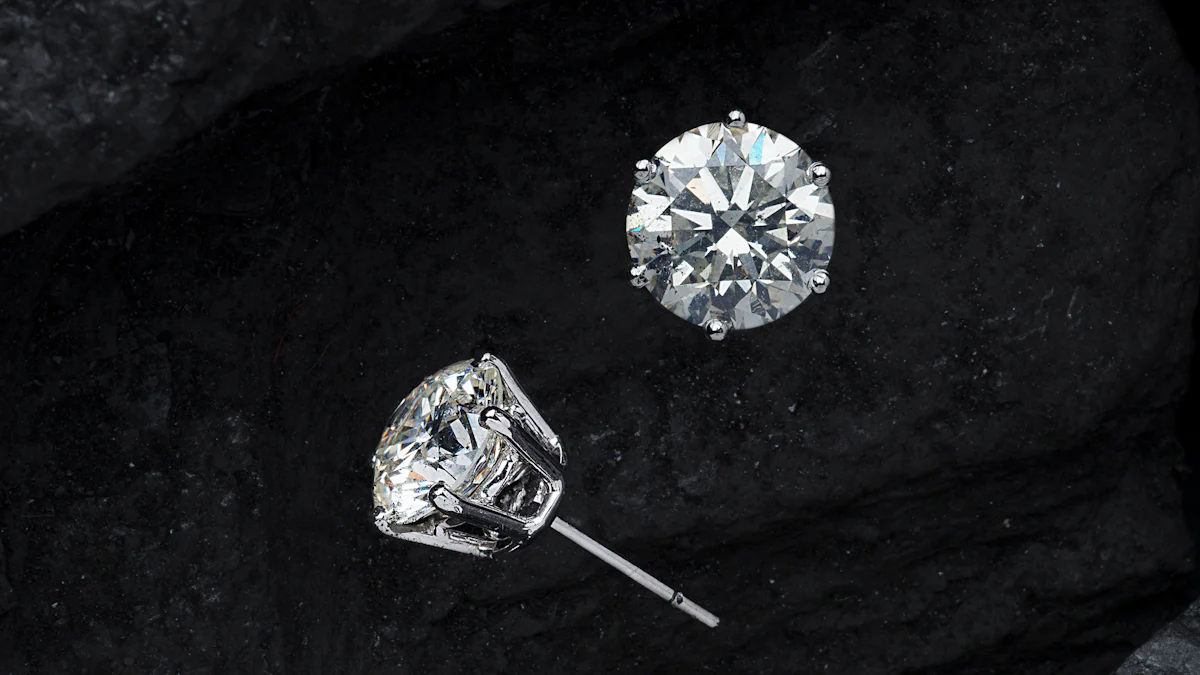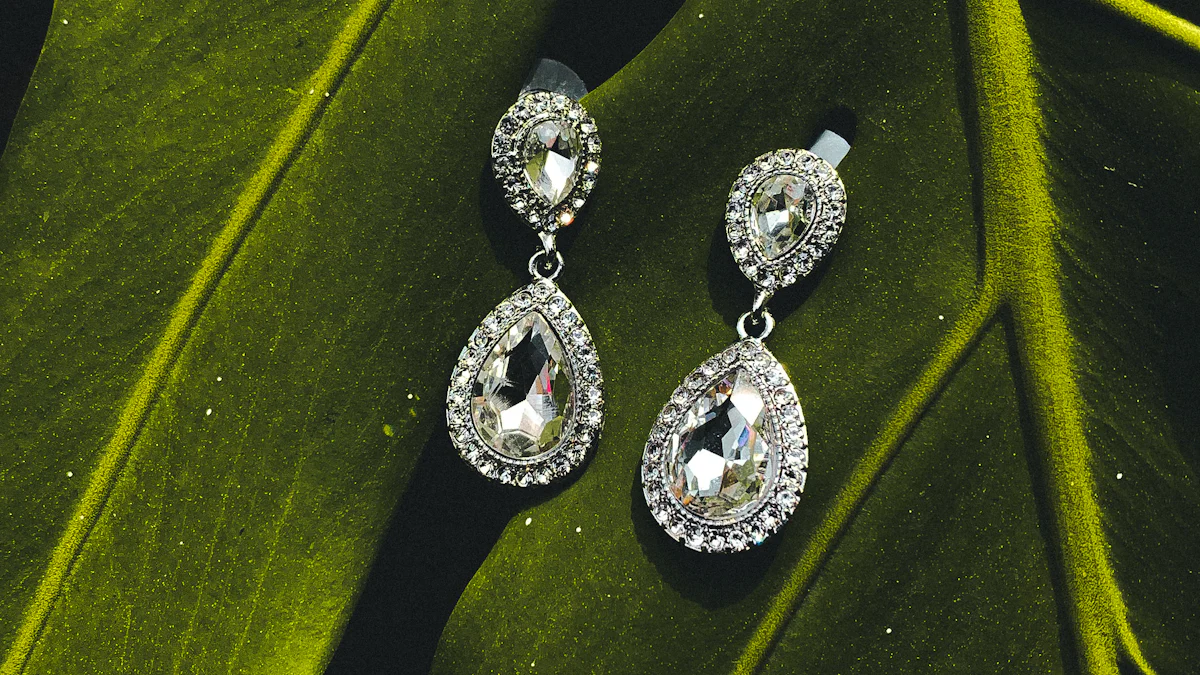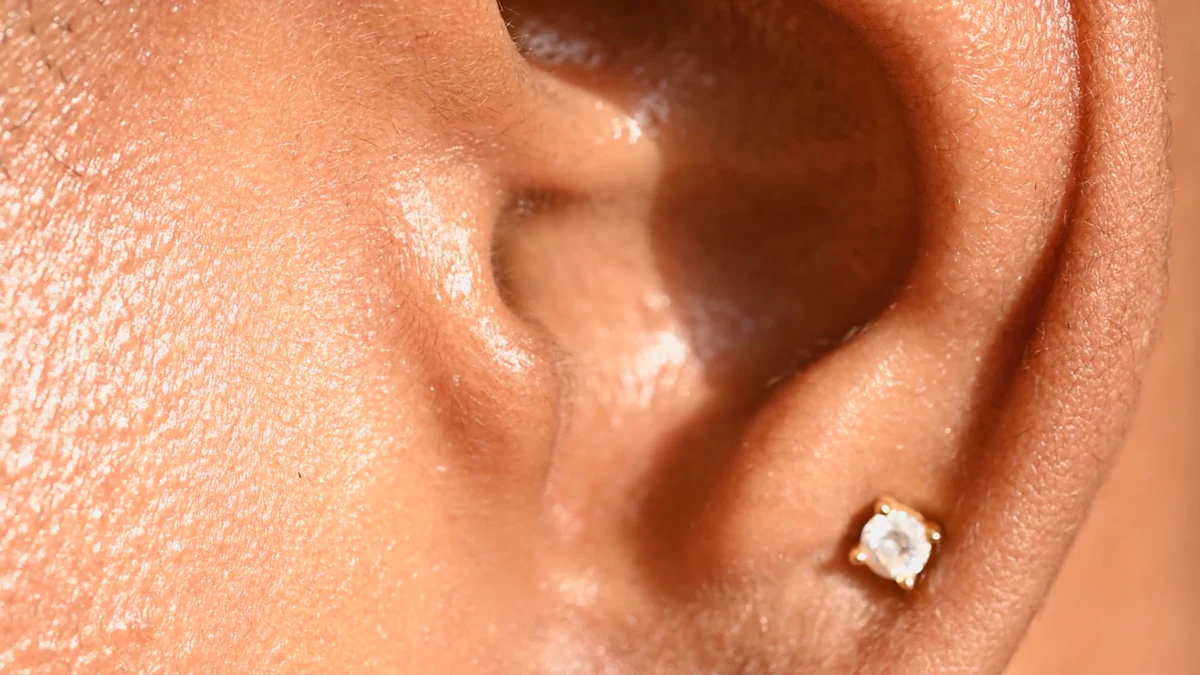What to Know Before Buying 2 1/2 Carat Diamond Earrings

Purchasing 2 1/2 carat diamond earrings is a decision that requires careful thought. These earrings are more than just accessories; they represent a significant investment and a bold style statement. To make the right choice, you need to understand the factors that influence their quality and value. Every detail, from the cut to the clarity, plays a role in their brilliance. By taking the time to educate yourself, you can ensure your diamond earrings reflect both your taste and your budget.
Understanding the 4Cs of 2 1/2 Carat Diamond Earrings

Cut: Maximizing Sparkle
The cut of a diamond determines how well it reflects light, directly influencing its sparkle and brilliance. When choosing 2 1/2 carat diamond earrings, you should prioritize a high-quality cut to maximize their visual impact. The Round Brilliant Cut is particularly popular for its unmatched sparkle. It features 58 facets, carefully arranged to reflect light and create exceptional fire and brightness. Other popular cuts for diamond earrings include the Princess cut, Cushion cut, and Pear-shaped diamonds.
The angles of the diamond also play a crucial role in its appearance. For example, a crown angle between 32º and 36º ensures light flashes back to the viewer, while a pavilion angle between 40.5º and 40.8º reflects light through the diamond’s table. These precise measurements enhance the overall brilliance, making the earrings stand out.
Color: Choosing the Right Shade
Diamond color significantly affects both appearance and value. The Gemological Institute of America (GIA) grades diamond color on a scale from D (colorless) to Z (light yellow or brown). Colorless diamonds are the most valuable due to their rarity and ability to reflect light brilliantly. They allow more light to pass through, enhancing their sparkle.
When selecting diamond earrings, consider how the metal setting influences the perceived color. White metals, such as platinum or white gold, complement colorless diamonds, while yellow gold can enhance diamonds with warmer tones. This interplay between the diamond and its setting ensures your earrings achieve the desired aesthetic.
Clarity: Evaluating Flaws
Diamond clarity refers to the presence of inclusions (internal flaws) and blemishes (surface flaws). These imperfections can affect the diamond’s transparency and brilliance. The GIA clarity scale categorizes diamonds into six main grades:
| Clarity Grade | Description | |-----------------------------|-----------------------------------------------------------------------------| | Flawless (FL) | No inclusions or blemishes visible under 10x magnification. | | Internally Flawless (IF) | No inclusions visible, but minor blemishes may be present. | | Very, Very Slightly Included (VVS1, VVS2) | Inclusions are extremely difficult to detect, even for skilled graders. | | Very Slightly Included (VS1, VS2) | Inclusions are minor and require effort to observe. | | Slightly Included (SI1, SI2) | Inclusions are noticeable under magnification. | | Included (I1, I2, I3) | Inclusions are obvious and may affect brilliance and durability. |
For 2 1/2 carat diamond earrings, aim for a clarity grade that balances visual appeal and budget. Diamonds with minor inclusions, such as VS1 or VS2, often appear flawless to the naked eye, making them an excellent choice for earrings.
Carat: Size and Weight Considerations
Carat refers to the weight of a diamond, and it plays a significant role in determining its size and value. When you choose 2 1/2 carat diamond earrings, you are selecting a pair of diamonds with a combined weight of 2.5 carats. Each diamond in the pair typically weighs 1.25 carats.
The carat weight affects the physical size of the diamond. However, two diamonds with the same carat weight may appear different in size due to variations in their cut. A well-cut diamond maximizes its surface area, making it look larger and more brilliant. For earrings, this can enhance their overall presence and sparkle.
You should also consider how carat weight impacts comfort. Larger diamonds can feel heavier on your ears, especially if you plan to wear the earrings for extended periods. Lightweight settings can help balance the weight and improve comfort without compromising style.
Carat weight also influences the price of diamond earrings. Larger diamonds are rarer, which makes them more expensive. However, you can achieve a similar visual impact by choosing diamonds slightly below 2 1/2 carats. For example, earrings with a total weight of 2.4 carats may look nearly identical but cost less.
When selecting carat weight, think about your personal style and how the earrings will complement your wardrobe. Larger diamonds make a bold statement, while smaller ones offer a more subtle elegance. By understanding carat weight, you can find the perfect balance between size, comfort, and budget.
Selecting the Perfect Setting and Backing for Diamond Earrings

Popular Setting Styles
The setting style of your diamond studs plays a crucial role in their appearance and durability. When selecting diamond studs, you should consider how the setting enhances the diamonds' brilliance and protects them from damage.
A bezel setting is recommended for safeguarding diamonds from accidental knocks and preventing them from falling out. This is often the best choice for everyday wear.
Other popular styles include:
- Prong Settings: These settings use small metal claws to hold the diamonds securely while allowing maximum light to pass through. They create a classic and elegant look.
- Martini-Style Settings: These settings maximize diamond visibility by positioning the diamonds close to the ear. However, they may cause discomfort by digging into the skin.
- Halo Settings: These settings surround the diamonds with smaller stones, adding extra sparkle and making the diamonds appear larger.
The choice of metal also impacts the setting's durability and style. Platinum offers maximum durability and hypoallergenic properties, while 18KT and 14KT gold provide a balance of strength and affordability.
Backing Options for Comfort and Security
The backing of your diamond stud earrings determines how securely they stay in place. Each type of backing has its own advantages and disadvantages:
| Earring Back Type | Advantages | Disadvantages | |-------------------|------------|----------------| | Friction Backs | Comfortable, small and discreet | Less secure, can lose grip over time | | Push Backs | Easy to use, cost-effective | Can snag on clothing, may develop ear gunk | | Screw Backs | Secure fit, good for sensitive ears | Can be difficult to remove, may become loose | | Safety Lock Backs | Secure for children, easy to use | Limited to specific designs | | La Pousette Backs | Combines security and ease of use | May be hard for those with dexterity issues | | Flat Backs | Hygienic, comfortable for new piercings | May require customization, tricky to insert/remove |
When choosing diamond studs, you should prioritize backings that balance comfort and security. Screw backs are ideal for sensitive ears, while friction backs offer a discreet and lightweight option.
Matching Style with Practicality
The setting and backing of your diamond studs should align with your lifestyle and preferences. Bezel settings provide excellent security but may obscure part of the diamonds. Martini-style settings highlight the diamonds' brilliance but might not suit all-day wear.
The metal choice also affects practicality. Platinum is the most durable option for everyday wear, while yellow gold can hide yellowish tints in diamonds. Consider how often you plan to wear your diamond stud earrings and select a combination of setting and backing that ensures both style and comfort.
By carefully choosing diamond studs with the right setting and backing, you can enjoy a perfect blend of elegance and practicality.
Balancing Size, Quality, and Budget for 2 1/2 Carat Diamond Earrings
Quality vs. Size: Making the Right Choice
When purchasing 2 1/2 carat diamond earrings, you must decide whether to prioritize size or quality. Larger diamonds often make a bold statement, but their brilliance depends on their cut, color, and clarity. High-quality diamonds with fewer imperfections and a near-colorless appearance tend to have greater sparkle and value.
To evaluate diamond quality, focus on the four Cs:
- Carat – Determines the weight and size of the diamond.
- Cut – Impacts how well the diamond reflects light.
- Color – Affects the diamond's appearance and rarity.
- Clarity – Indicates the presence of inclusions or blemishes.
Many people prefer fewer high-quality pieces over multiple lower-quality ones. By understanding these factors, you can strike the right balance between size and diamond quality without exceeding your budget.
Natural vs. Lab-Grown Diamonds
Choosing between natural and lab-grown diamonds can significantly impact your purchase. Natural diamonds are rare and maintain their value better over time. They also support mining communities economically. However, they come with a higher price tag due to their demand and the lack of innovation in mining processes.
Lab-grown diamonds, on the other hand, are more affordable and eco-friendly. They can cost 80-95% less than natural diamonds. For example, a 1-carat natural diamond may cost around $2,500, while a lab-grown equivalent of the same quality costs about $500. Despite their lower cost, lab-grown diamonds offer the same brilliance and durability as natural ones.
If you want a more budget-friendly option without compromising on appearance, lab-grown diamonds are worth considering.
Setting a Realistic Budget
Setting a realistic budget ensures you get the best value for your money. The price of 2 1/2 carat diamond earrings varies based on the quality of the diamonds. For instance, a 2-carat diamond can range from $8,050 to $84,360, with an average price of $15,280 for a good-quality diamond.
When planning your budget, consider how the four Cs influence the price. Higher-quality diamonds cost more, but they also offer better brilliance and durability. If your budget is limited, you can opt for slightly smaller diamonds or lab-grown options to achieve a similar look at a lower cost.
By carefully balancing size, quality, and budget, you can find diamond stud earrings that meet your needs and preferences.
Ensuring Authenticity and Certification of Diamond Earrings
Importance of Certification
When buying diamond stud earrings, certification is essential to ensure you receive genuine and high-quality diamonds. A diamond certificate, issued by a reputable gemological laboratory, provides a detailed evaluation of the diamond’s 4Cs—cut, color, clarity, and carat weight. This document serves as a quality assurance tool, giving you confidence in your purchase.
Certified diamonds offer several advantages:
- Quality Assurance: Certification guarantees an accurate assessment of the diamond’s characteristics, ensuring you get what you pay for.
- Comparison: With a certificate, you can compare diamonds easily and choose the one that offers the best value for your budget.
- Confidence: Knowing your diamond is certified gives you peace of mind about its authenticity and quality.
- Resale Value: If you decide to sell or upgrade your earrings, certification simplifies the process by verifying the diamond’s value.
- Insurance: Most insurance companies require a certificate to properly insure your diamond earrings.
- Protection Against Fraud: Certification protects you from purchasing fake or misrepresented diamonds.
Always request a certificate when purchasing diamonds to ensure you’re making a secure and informed investment.
Buying from Trusted Jewelers
Choosing a trusted jeweler is just as important as obtaining certification. Reputable jewelers work with well-known certification organizations to provide accurate grading reports. The most recognized certification labs include:
| Rank | Organization | Notes | |------|--------------|--------------------------------------------| | 1 | GIA | Most reputable and widely recognized | | 2 | AGS | Highly trusted for grading | | 3 | HRD | Considered reliable | | 4 | IGI | Improving grading process | | 5 | EGL | Subject to controversy and criticism |
The Gemological Institute of America (GIA) is widely regarded as the gold standard for diamond certification. It provides consistent and reliable grading, especially for color, clarity, and cut. The American Gem Society (AGS) is another highly trusted organization. While other labs like HRD and IGI are reliable, EGL has faced criticism for inconsistencies in its grading process.
When selecting a jeweler, look for those who partner with GIA or AGS. Trusted jewelers also provide transparent information about their diamonds and offer excellent customer service. By purchasing from a reputable source, you can feel confident in the authenticity and quality of your diamond stud earrings.
Caring for Your Diamond Earrings
Cleaning and Maintenance Tips
Keeping your diamond earrings clean ensures they maintain their sparkle and brilliance. Regular cleaning removes dirt, oils, and buildup that can dull their shine. Follow these simple steps to care for your earrings:
- Rinse your earrings in warm water carefully. Avoid direct running water to prevent accidental loss.
- Use a gentle dish soap mixed with warm water. Ensure the soap contains no added moisturizers or fragrances.
- Soak your earrings for 15-20 minutes. This loosens dirt and grime from hard-to-reach areas.
- Use a soft-bristled toothbrush to clean the nooks and crannies of the earrings. Pay special attention to the posts and backings, as these areas often collect buildup from wear.
- Avoid harsh chemicals, extreme temperatures, and products like moisturizers or fragrances. These can dull the sparkle of your diamonds over time.
By following these steps, you can keep your diamond stud earrings looking as brilliant as the day you bought them.
Proper Storage Practices
Proper storage prevents damage and preserves the beauty of your diamond earrings. Diamonds are durable but can scratch other jewelry if stored improperly. Use these tips to protect your earrings:
- Store each piece in a soft pouch to prevent scratches and dust accumulation.
- Use compartmentalized storage to keep your earrings separate from other jewelry. This avoids direct contact between pieces, which can cause damage.
- Keep your earrings away from chemicals like perfumes and lotions. These substances can tarnish the metal and reduce the brilliance of the diamonds.
Taking the time to store your earrings correctly ensures they remain in excellent condition for years to come.
Understanding the 4Cs helps you evaluate the quality and value of diamond earrings. Choosing the right setting and backing ensures both style and practicality. Balancing size, quality, and budget allows you to make a smart investment. Always verify authenticity with certification and buy from trusted jewelers.
Take your time to research and compare options. Consult reputable jewelers to gain expert advice. Owning diamond stud earrings brings elegance and joy to your collection. These timeless pieces will enhance your style for years to come.
FAQ
What is the best cut for diamond stud earrings?
The Round Brilliant Cut is the most popular choice. It maximizes sparkle and brilliance, making your earrings stand out. Other cuts, like Princess or Cushion, also work well depending on your style preference.
How can I tell if a diamond is real?
Request a certification from a reputable gemological lab like GIA. You can also perform simple tests, such as the fog test, or consult a trusted jeweler for verification.
Are lab-grown diamonds as durable as natural ones?
Yes, lab-grown diamonds have the same physical and chemical properties as natural diamonds. They are equally durable and brilliant, making them a great alternative.
How often should I clean my diamond stud earrings?
Clean your earrings every two weeks to maintain their sparkle. Use warm water, mild soap, and a soft brush to remove dirt and oils.
Can I wear diamond stud earrings every day?
Yes, you can wear them daily. Choose a secure setting, like a bezel or prong, and ensure the backing is comfortable and reliable for everyday use.
See Also
Exploring the Size of a 2.25 Carat Diamond
Determining the Price of a 2 Carat Lab Diamond
Essential Elements That Influence Diamond Ring Costs

